check engine MERCEDES-BENZ SPRINTER 2019 MY19 with no MMS Operator’s Manual
[x] Cancel search | Manufacturer: MERCEDES-BENZ, Model Year: 2019, Model line: SPRINTER, Model: MERCEDES-BENZ SPRINTER 2019Pages: 322, PDF Size: 5.91 MB
Page 31 of 322
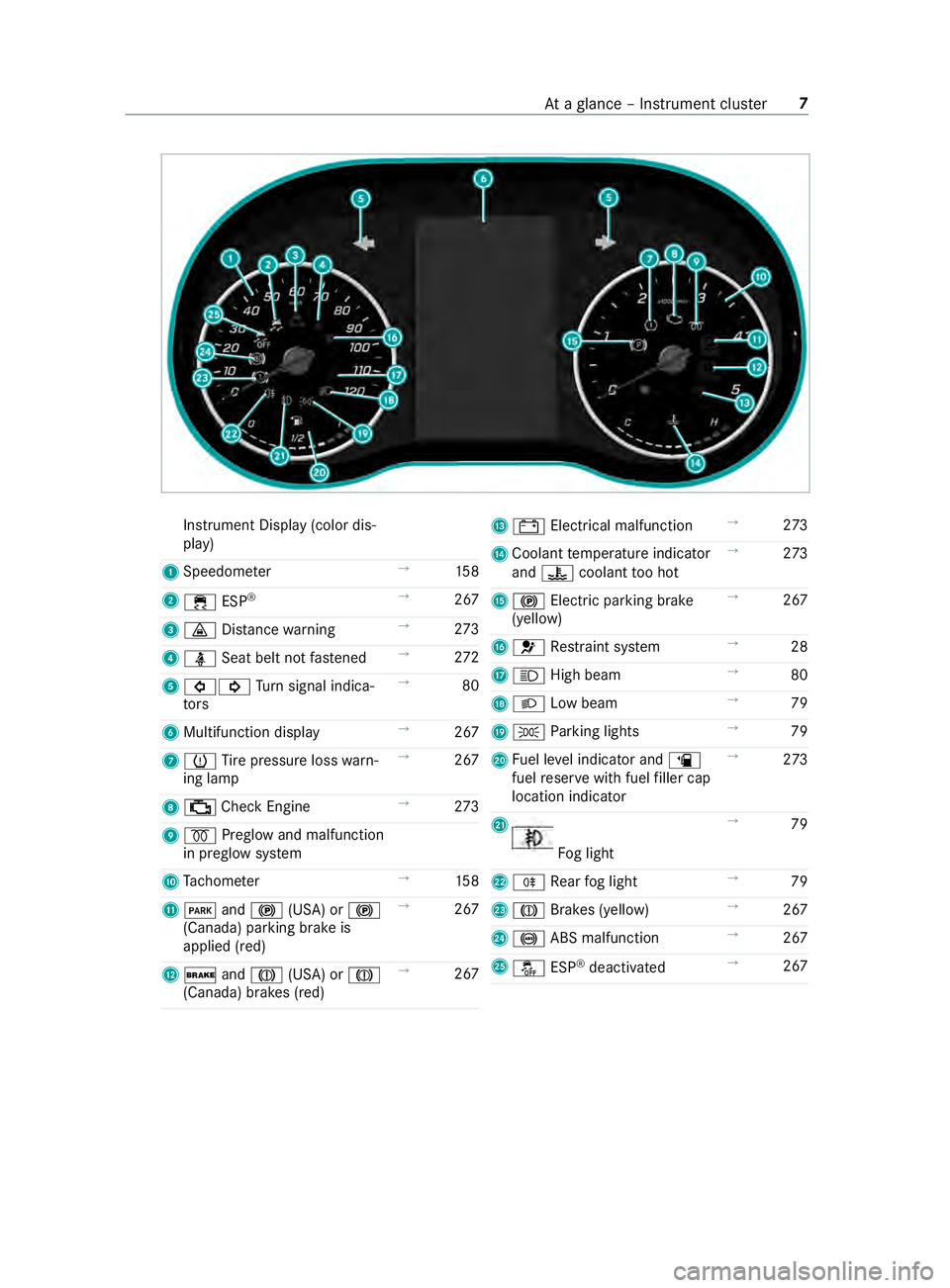
Instrument Displa
y(color dis‐
play)
1 Speedome ter →
15 8
2 00E5 ESP®
→
267
3 00BA Distance warning →
273
4 00E9 Seatbeltn otfastened →
272
5 003E003D Turn signal indica‐
to rs →
80
6 Multifunction display →
267
7 0077 Tire pressur eloss warn‐
ing lamp →
267
8 00B9 CheckEngine →
273
9 0028 Preglo wand malfunction
in preglo wsystem
A Tach ome ter →
15 8
B 0049 and0024 (USA) or 0024
(Canada) parkin gbrake is
applied (red) →
267
C 0027 and004D (USA) or 004D
(Canada) brakes (red) →
267 D
003D Electrical malfunction →
273
E Coolan ttemperatur eindicator
and 00AC coolant tooh ot →
273
F 0024 Electric pa rking brake
(yellow) →
267
G 0075 Restra int sy stem →
28
H 0057 High beam →
80
I 0058 Lowb eam →
79
J 0060 Parking lights →
79
K Fuel le velindicator and 00D4
fuel reser vewit hfuel filler cap
location indicator →
273
L Fo
glight →
79
M 005E Rear fogl ight →
79
N 004D Brakes (yellow) →
267
O 0025 ABS malfunction →
267
P 00BB ESP®
deactivated →
267 At
ag lanc e–I nstrument clus ter7
Page 32 of 322
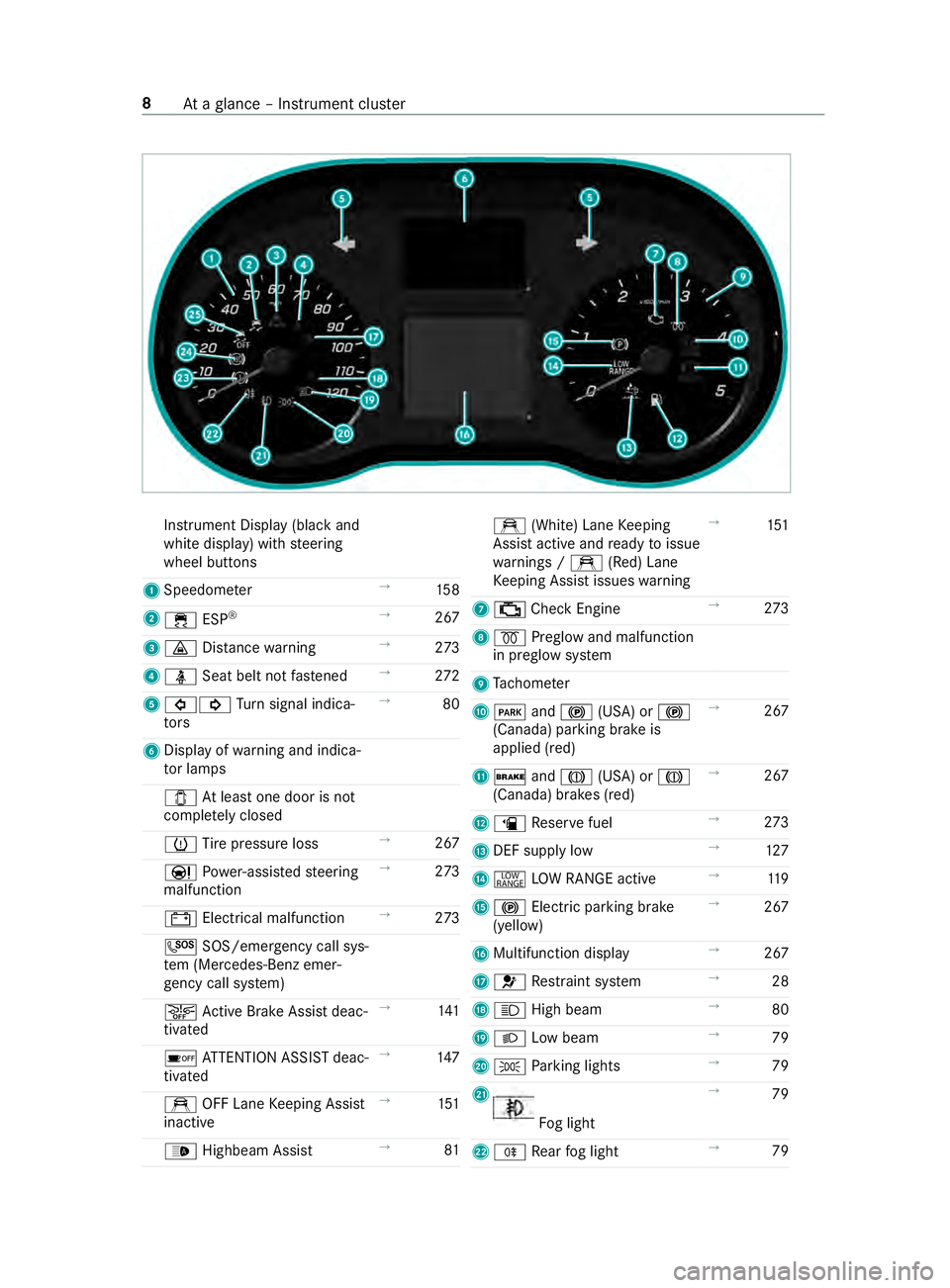
Instrument Displa
y(bla ckand
whit edisplay) wit hsteering
wheel buttons
1 Speedome ter →
15 8
2 00E5 ESP®
→
267
3 00BA Distance warning →
273
4 00E9 Seatbeltn otfastened →
272
5 003E003D Turn signal indica‐
to rs →
80
6 Displ ayofwa rning and indica‐
to rlamps
003E Atleas tone door is not
comple tely closed
0077 Tire pressur eloss →
267
00CC Powe r-assis teds teering
malfunction →
273
003D Electrica lmalfunction →
273
0053 SOS/emergency cal lsys‐
te m( Mercedes-Benz emer‐
ge ncy cal lsyst em)
00D4 ActiveB rake Assi stdeac‐
tivated →
141
00D7 ATTENTION ASSIS Tdeac‐
tivated →
147
e OFF Lane Keeping Assist
inactive →
151
00CE Highbea mAssist →
81 e
(White) Lane Keeping
Assis tactiv eand ready toissue
wa rnings / e(Red) Lane
Ke eping Assis tissues warning →
151
7 00B9 CheckEngine →
273
8 0028 Preglo wand malfunction
in preglo wsystem
9 Tach ome ter
A 0049 and0024 (USA) or 0024
(Canada) parkin gbrake is
applied (red) →
267
B 0027 and004D (USA) or 004D
(Canada) brakes (red) →
267
C 00D4 Reser vefuel →
273
D DEF supply low →
127
E 002E LOWR ANGE active →
11 9
F 0024 Electric pa rking brake
(yellow) →
267
G Multifunction display →
267
H 0075 Restra int sy stem →
28
I 0057 High beam →
80
J 0058 Lowb eam →
79
K 0060 Parking lights →
79
L Fo
glight →
79
M 005E Rear fogl ight →
79 8
Atag lanc e–Instru ment clus ter
Page 65 of 322

SmartK
ey Note
sonr adio connection softhekey &
DANG ER Risk of fata linjur ytop ersons
wit hm edical devices from thee lectro‐
magnetic radiation of thes tart/s topb ut‐
ton
Pe rsons wit hmedical devices, e.g. pacemak‐
er sord efibrillators:
When youo perat ethe start/ stop button, a
ra dio connection is es tablished between the
ke ya nd thev ehicle.
The electromagnetic radiation can af fect the
functionality of amedical device. #
Befor eoperating thev ehicle, consult
yo ur doc torort he manufacturer of the
medica ldevice abou tany possible
ef fects of emissions from suc hsystems. De
tection rang eoft he KEYLESS-S TART func‐
tion antenna Overvie
wofSmartK eyfunctions &
WARNING Risk of accident and inju ry
due tochildren lef tunat tende dint he
ve hicle
If ch ildren ar eleftu nat tende dint hevehicle,
th ey could:
R opendoors,t hereb yendangering other
persons or road users.
R geto utofthev ehicle and be hit by
oncomin gtraffic.
R operat evehicle equipment and become
trapped, fore xamp le.
In addition ,children could also se tthe vehicle
in motion, fore xamp le,by:
R releasing thep arking brake. R
shifting thea utomatic transmission out of
par kposition 005D.
R startin gthe engine #
Neverlea ve children and animals unat‐
te nde dint hevehicle. #
When leaving thev ehicle, alw ayst ake
th eS martK eywit hyou and loc kthe
ve hicle. #
Keep theS martK eyout of ther eac hof
ch ildren. *
NO
TEDama getothek eycaused bymag‐
netic fields #
Keep thek eyaway from strong mag‐
netic fields. 1
Tolock
2 Battery checkl amp
3 Tounlo ck
4 Tounlo ckthec argo compartmen t(sliding
door sand rear-en ddoors)/ tounlo ckand
open/close electric slidin gdoors
5 Mechanical key
The SmartK ey's factor ysetting enables youto
centrally loc kand unloc kthe following compo‐
nents:
R The driver's door and thec o-driver door
R The sliding doors
R The rear-en ddoors
% If
yo udon otopen thev ehicle within appr ox‐
imatel y40seconds of unlocking, thev ehicle
will loc kagain and anti-thef tprotection will
be activated again. Opening and closing
41
Page 108 of 322
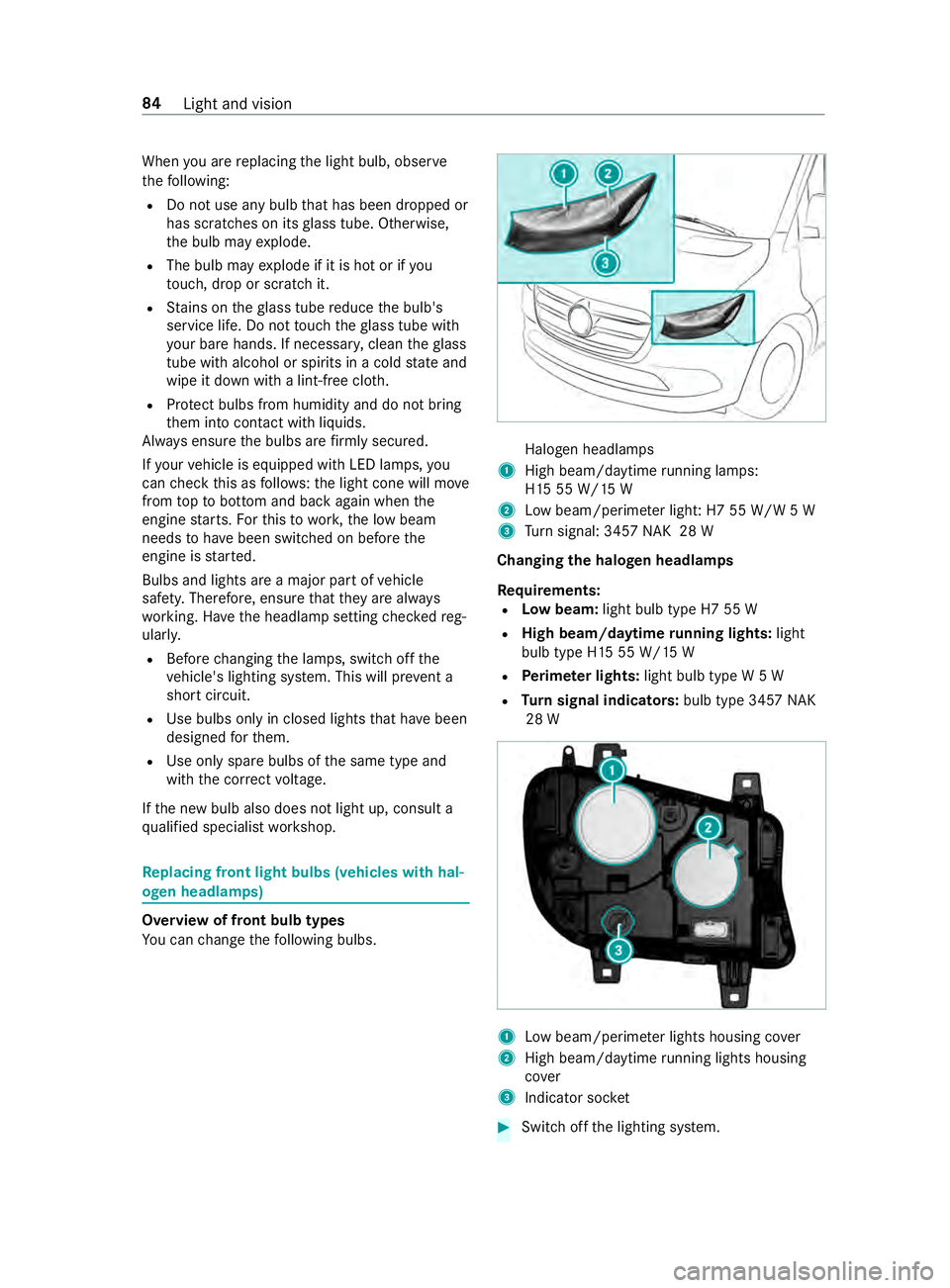
When
youa re re placing thel ight bulb, obser ve
th ef ollowing:
R Do no tuse an ybulb that has been dropped or
has scratches on its glass tube .Otherwise,
th eb ulb ma yexplode.
R Theb ulb ma yexplod eifitish otor if you
to uch, drop or sc ratchi t.
R Stains on theg lass tube reduce theb ulb's
service life. Do no ttouc hthe glass tube with
yo ur bar ehands. If necessar y,clea nthe glass
tube wit halcohol or spirits in acolds tate and
wipe it down wit halint-freec loth.
R Protect bulbs from humidity and do no tbring
th em int ocontact wit hliquids.
Alw ayse nsur ethe bulbs ar efirml ysecured.
If yo ur vehicle is equipped wit hLED lamps, you
can checkt his as follo ws :the light cone will mo ve
from toptob ottomand bac kagain when the
engine starts .For this to wo rk,the lo wbeam
needs tohave been switched on befor ethe
engine is star ted.
Bulbs and lights ar eamajor par tofvehicle
saf ety. Therefore, ensur ethat they area lways
wo rking. Ha vetheh eadlam psetting checkedr eg‐
ular ly.
R Befor echanging thel amps, switc hoffthe
ve hicle's lighting sy stem. This will pr event a
sho rtcircuit.
R Use bulbs only in closed lights that ha vebeen
designed fort hem.
R Use onl yspar ebulbs of thes ame type and
wit hthe cor rect voltage.
If th en ew bulb also does no tlight up, consult a
qu alified specialis tworks hop. Re
placing fron tlight bulbs (vehicles with hal‐
ogen headlamps) Overvie
woffront bul btypes
Yo uc an chang ethe following bulbs. Halogen headlamps
1 High beam/daytime running la mps:
H1 555W /15W
2 Lowb eam/perime terl igh t:H7 55 W/W 5W
3 Turn signal: 345 7NAK 28 W
Changing the halogen headla mps
Re quirements:
R Lowb eam: light bulb type H7 55 W
R High beam/daytim erunnin glights: light
bulb type H1 555W/15W
R Perime terl ights: light bulb typ eW5W
R Turn signal indicators: bulb type 3457NAK
28 W 1
Lowb eam/perime terl ights housing co ver
2 High beam/daytim erunnin glights housing
co ver
3 Indicator soc ket #
Switc hoffthel ighting sy stem. 84
Light and vision
Page 125 of 322
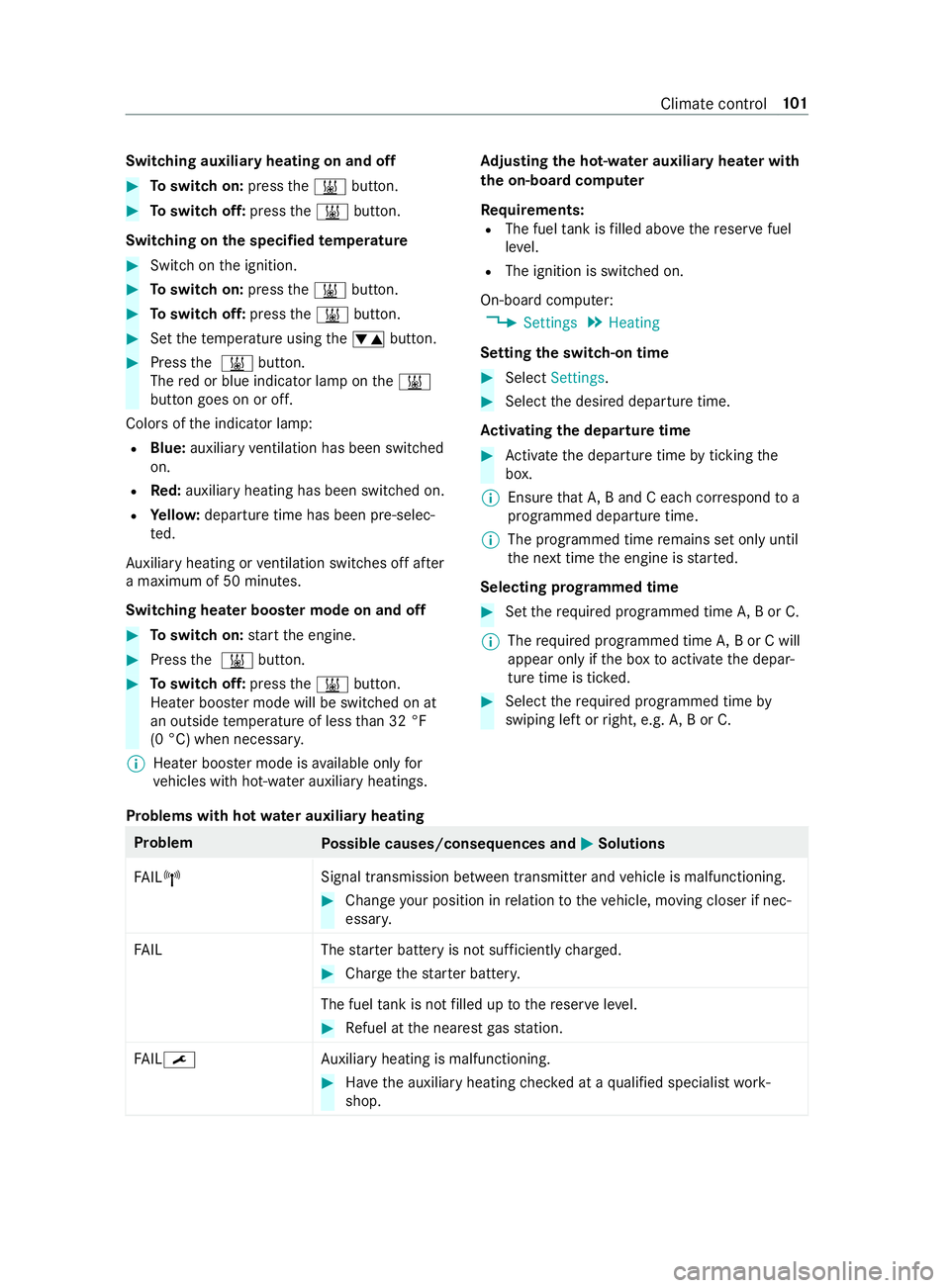
Switching auxiliar
yheating on and off #
Toswitc hon:press the003B button. #
Toswitc hoff:press the003B button.
Switching on thes pecified temperature #
Swit chon thei gnition. #
Toswitc hon:press the003B button. #
Toswitc hoff:press the003B button. #
Setthe temp eratur eusing the0082 button. #
Press the003B button.
The redorb lue indicator lam ponthe003B
button goes on or off.
Color softhe indicator lamp:
R Blue: auxiliar yventilation has been switched
on.
R Red:auxilia ryheating has been switched on.
R Yello w: departur etime has been pre-selec‐
te d.
Au xilia ryheating or ventilation switches of fafter
am aximum of 50 minutes.
Swit ching heater boos term ode on and off #
Toswitc hon:star tt he engine. #
Press the003B button. #
Toswitc hoff:press the003B button.
Heater boos term ode willbes witched on at
an outsid etemperatur eoflessthan 32 °F
(0 °C) when necessar y.
% Heater boo
ster mode is available onl yfor
ve hicles wit hhot-water auxiliary heatings. Ad
justin gthe hot-water auxiliar yheaterw ith
the on-boar dcom puter
Re quirements:
R The fuel tank is filled abo vether eser vefuel
le ve l.
R The ignition is switched on.
On-boar dcomputer:
4 Settings 5
Heating
Setting thes witch-on time #
Select Settings. #
Selec tthe desired departur etime.
Ac tivatin gthe departur etime #
Activat ethe departur etime byticking the
box.
% Ensur
ethat A,Ba ndCe achc orrespond to a
programmed departur etime.
% The programmed time
remains se tonlyu ntil
th en exttime thee ngine is star ted.
Selecting prog rammed time #
Setthe requ ired programmed tim eA,BorC.
% The
requ ired prog rammed time A,BorC will
appea ronly if theb oxtoactivat ethe depar‐
tur etime is tic ked. #
Select ther equired programmed time by
swiping lef torright, e.g. A,BorC.
Problems with ho twater auxiliar yheating Problem
Possible causes/consequences and 0050 0050Solutions
FA IL00A3 Signal transmission between transmitter and
vehicle is malfunctioning. #
Chang eyour position in relation tothev ehicle, moving closer if nec‐
essar y.
FA IL Thestar terb atter yisn otsuf ficiently charge d. #
Charg ethe star terb atter y.
The fuel tank is no tfilled up tother eser veleve l. #
Refuel at then eares tgas station.
FA IL0099 Au
xilia ryheating is malfunctioning. #
Have thea uxiliar yheating checkedataq ualified specialis twork‐
shop. Climat
econtrol 101
Page 127 of 322
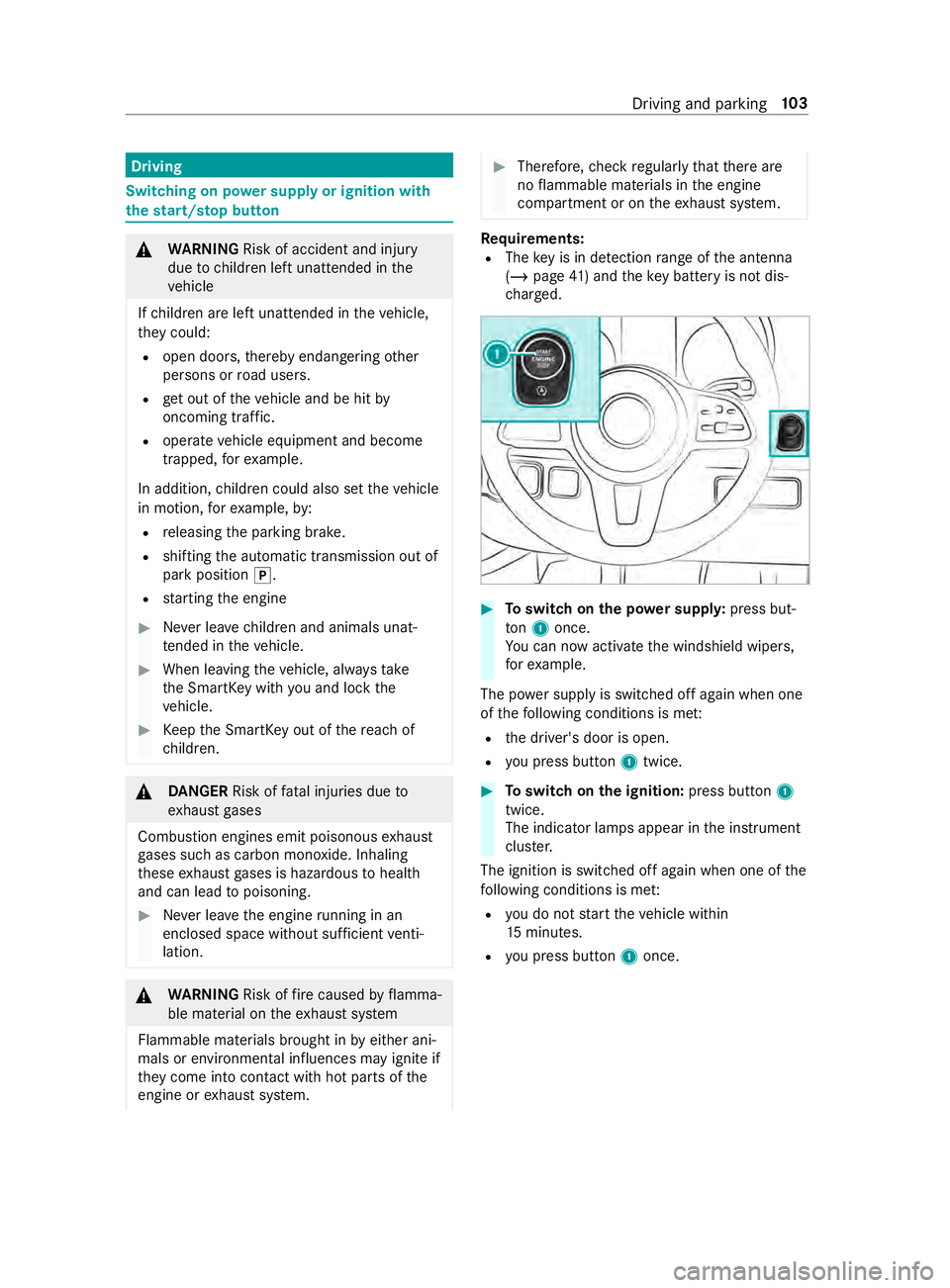
Driving
Swit
ching on po wersuppl yori gnitionw ith
the start/s topb utton &
WARNING Risk of accident and inju ry
due tochildren lef tunat tende dint he
ve hicle
If ch ildren ar eleftu nat tende dint hevehicle,
th ey could:
R opendoors,t hereb yendangering other
persons or road users.
R geto utofthev ehicle and be hit by
oncomin gtraffic.
R operat evehicle equipment and become
trapped, fore xamp le.
In addition ,children could also se tthe vehicle
in motion, fore xamp le,by:
R releasing thep arking brake.
R shifting thea utomatic transmission out of
par kposition 005D.
R startin gthe engine #
Neverlea ve children and animals unat‐
te nde dint hevehicle. #
When leaving thev ehicle, alw ayst ake
th eS martK eywit hyou and loc kthe
ve hicle. #
Keep theS martK eyout of ther eac hof
ch ildren. &
DANG ER Risk of fata linjuries due to
ex haus tgases
Combustio nengines emit poisonous exhaust
ga ses suc hascarbon monoxide. Inhaling
th ese exhaus tgases is hazardou stohealth
and can lead topoisoning. #
Neverlea ve thee ngine running in an
enclose dspace wi thout suf ficient venti‐
lation. &
WARNING Risk offire caused byflamma‐
ble material on thee xhau stsystem
Flammable materials brought in byeither ani‐
mals or environmen talinfluences ma yignit eif
th ey come int ocontact wi thhotp arts of the
engine or exhaus tsystem. #
Therefore, checkr egularly that ther ea re
no flammable materials in thee ngine
compartmen torontheexhaus tsystem. Re
quirements:
R The keyisind etection rang eoft he antenna
(/ page41) and thek eybat tery is no tdis‐
ch arge d. #
Toswitc hont he powersuppl y:press but‐
ton 1once.
Yo uc an no wactivat ethe windshield wipers,
fo re xamp le.
The po wersupp lyis switched of fagain when one
of thef ollowing condition sismet:
R thed rive r's door is open.
R youp ress button 1twice. #
Toswitc hont he ignition: press button1
twice.
The indicator lamps appear in thei nstrument
clus ter.
The ignition is switched of fagain when one of the
fo llowing condition sismet:
R youdon otstar tt he vehicle within
15 minutes.
R youp ress button 1once. Drivin
gand parking 103
Page 129 of 322
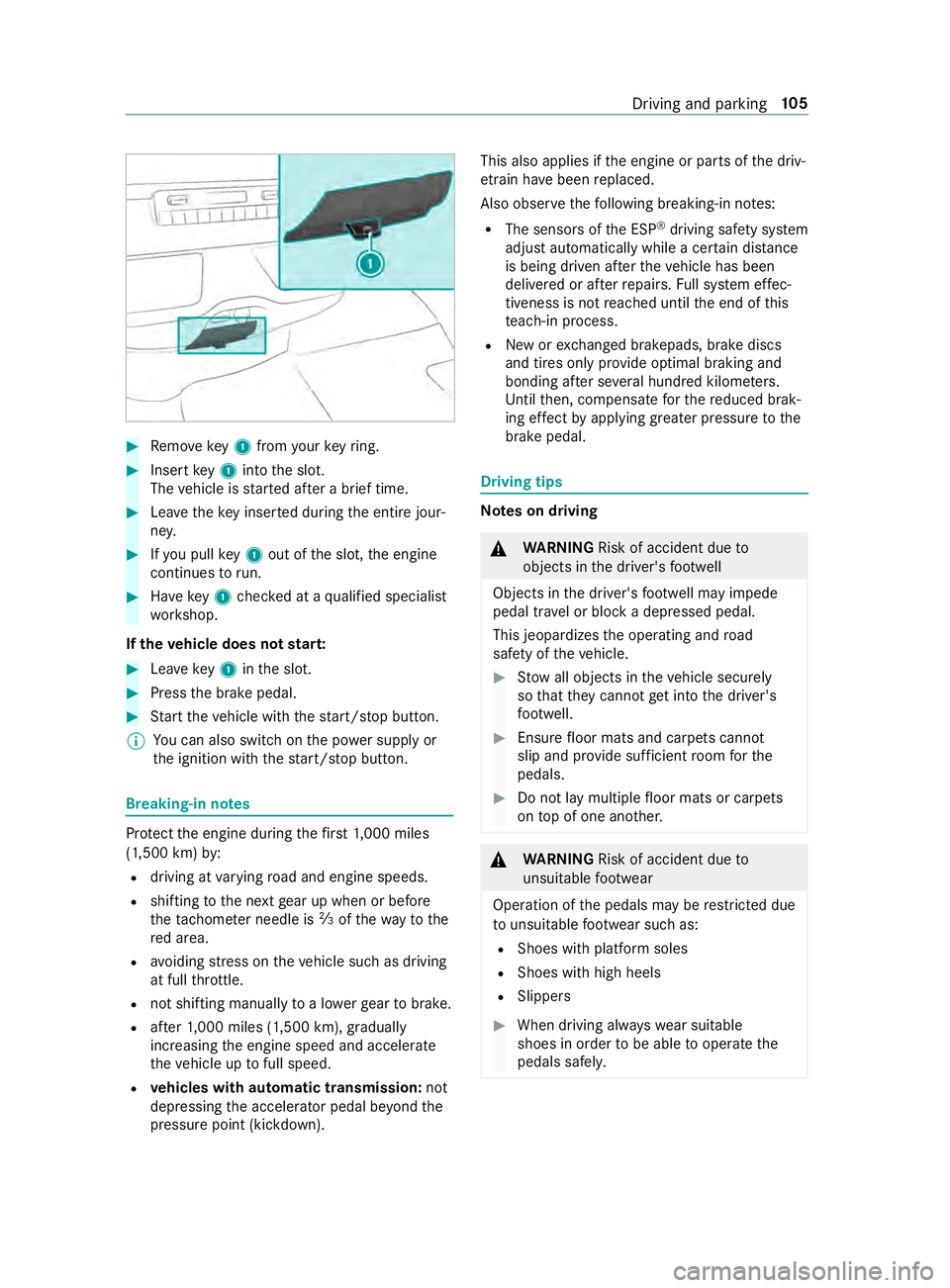
#
Remo vekey 1from your keyr ing. #
Inser tkey 1 intot he slot.
The vehicle is star teda fter ab rief time. #
Leavethek eyinser tedd uring thee ntir ejour‐
ne y. #
Ifyo up ullkey 1out of thes lot, thee ngine
continues torun. #
Have key 1checkedataq ualified specialist
wo rkshop.
If th ev ehicle doe snotstar t: #
Leavekey 1inthes lot. #
Press theb rake pedal. #
Startt he vehicle wit hthe start/ stop button.
% Yo
uc an also swit chon thep ower suppl yor
th ei gnition wit hthe start/ stop button. Breaking-in no
tes Pr
otect thee ngine during thef irst 1,000 miles
(1,500 km) by:
R driving at varying road and engine speeds.
R shiftin gtothe next gear up when or before
th et achome tern eedle is 00C3ofthew ay to the
re da rea.
R avoiding stre ss on thev ehicle suc hasdriving
at full thro ttle.
R nots hifting manuall ytoalowergear tobrake.
R afte r1 ,000 miles (1,50 0km),gradually
increasing thee ngine speed and accelerate
th ev ehicle up tofull speed.
R vehicles with automatic transmission: not
depressing thea ccelera torp eda lbeyo ndthe
pressur epoint (kickdown). This also applies if
thee ngine or parts of thed riv‐
et ra in ha vebeen replaced.
Also obser vethef ollowing breaking-in no tes:
R The sensor softhe ESP ®
driving saf etys ystem
adjus tautomaticall ywhile acertai nd ista nce
is bein gdrive na fter thev ehicle has been
delivered or af terr epairs. Full sy stem ef fec‐
tivenes sisnotreached until thee nd of this
te ach-in process.
R Newore xchanged brakepads, brak ediscs
and tires onl yprovide optimal braking and
bonding af ters everal hundred kilome ters.
Un tilthen, compensat efor ther educed brak‐
ing ef fect by applying greater pressur etothe
brak epedal. Driving tips
Note
sond riving &
WARNING Risk of accident du eto
object sinthe driver's foot we ll
Object sinthe driver's foot we ll ma yimp ede
pedal tr avel or bloc kadepressed pedal.
This jeopardizes theo perating and road
saf etyoft hevehicle. #
Stow all object sinthevehicle securely
so that they canno tget intot he driver's
fo ot we ll. #
Ensur efloor mats and carpets cannot
slip and pr ovide suf ficient room fort he
pedals. #
Do no tlay multiple floor mats or carpets
on topofo ne ano ther. &
WARNING Risk of accident du eto
unsuitable foot we ar
Operatio nofthe pedals ma yberestricted due
to unsuitable foot we ar suc has:
R Shoes wit hplatform soles
R Shoes wit hhigh heels
R Slippers #
When driving alw aysw ear suitable
shoes in order tobe able tooperat ethe
pedals safel y. Driving and pa
rking 105
Page 132 of 322
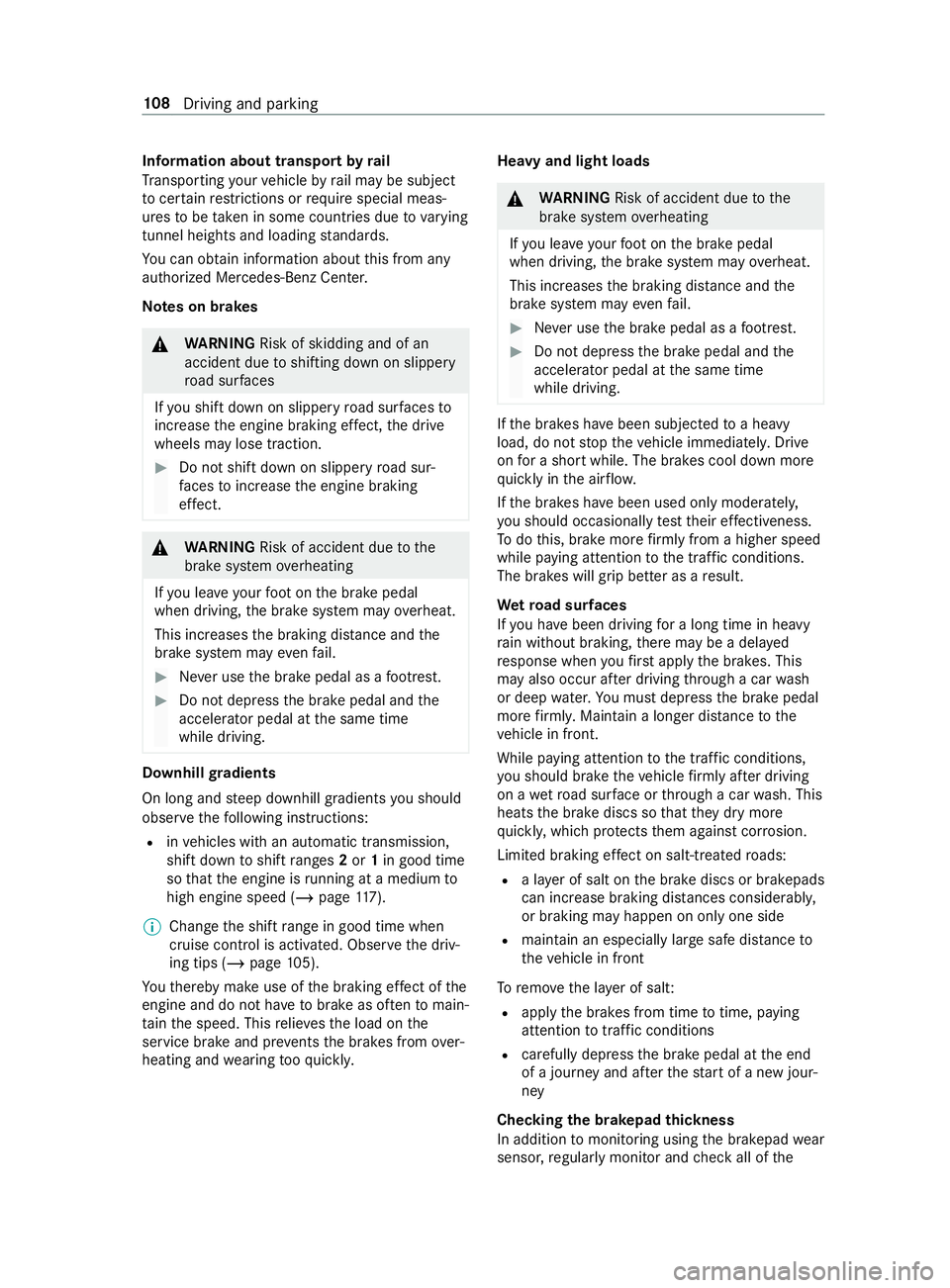
Information abou
ttranspor tbyrail
Tr ansportin gyour vehicle byrail ma ybes ubject
to cer tain restrictions or requ ires pecial meas‐
ures tobe take nins omecountrie sdue tovarying
tunnel height sand loading standards.
Yo uc an obtain information about this from any
authorized Mercedes-Benz Center.
Note sonb rakes &
WARNING Risk of skidding and of an
accident du etoshifting down on slippery
ro ad sur faces
If yo us hiftd ow nons lipperyroad sur faces to
inc rease thee ngine braking ef fect, thed rive
wheels ma ylose traction. #
Do no tshif td ow nons lipperyroad sur‐
fa ces toinc rease thee ngine braking
ef fect. &
WARNING Risk of accident du etothe
brak esystem overheating
If yo ul eave your foot on theb rake pedal
when driving, theb rake system ma yoverheat.
This increases theb raking dis tance and the
brak esystemm ayeve nfail. #
Neveru se theb rake pedal as afootrest. #
Do no tdepress theb rake pedal and the
accelerator pedal at thes ame time
while driving. Downhill
gradients
On long and steep downhill gradients yous hould
obse rvet he following instructions:
R invehicles wit hanautomatic transmission,
shif tdow ntos hiftranges 2or 1in good time
so that thee ngine is running at amediu mto
high engine speed (/ page117).
% Cha
nget he shif trang eing oodt ime when
cruise control is acti vated. Obser vethed riv‐
ing tips (/ page105).
Yo ut hereb ymakeu se of theb raking ef fect of the
engine and do no thave tobrak easo ften tomain‐
tai nt he speed. This relie vest he load on the
service brak eand pr events theb rake sf romo ver‐
heating and wearing tooq uickl y. Heavy and light loads &
WARNING Risk of accident du etothe
brak esystemo verheating
If yo ul eave your foot on theb rake pedal
when driving, theb rake system ma yoverheat.
This increases theb raking dis tance and the
brak esystemm ayeve nfail. #
Neveru se theb rake pedal as afootrest. #
Do no tdepress theb rake pedal and the
accelerator pedal at thes ame time
while driving. If
th eb rake sh aveb een subjected toah eavy
load, do no tstopt he vehicle immediately .Drive
on foras hortwhile. The brakes cool down more
qu ickl yint he air flow.
If th eb rake sh aveb een used onl ymoderatel y,
yo us houl doccasionall ytesttheir ef fectiveness.
To do this, brak emoref irml yfromah igher speed
while paying attention tothet raffic conditions.
The brakes will grip better as aresult.
We troad sur faces
If yo uh ave been driving foral ong time in heavy
ra in without braking, ther em aybe adelayed
re sponse when youf irst apply theb rake s. This
ma yalso occur af terd riving thro ugh acarwa sh
or deep water.Yo um ustd epress theb rake pedal
mor efirml y.Main tainal ongerd ista nc etot he
ve hicle in front.
While paying attention tothet raffic conditions,
yo us houl dbrakethe vehicle firm ly af terd riving
on aw etroad sur face or thro ugh acarwa sh. This
heats theb rake discs so that they drym ore
qu ickl y,whic hprotects them agains tcorrosion.
Limited braking ef fect on salt-trea tedr oads:
R alayer of salt on theb rake discs or brakepads
can increase braking dis tances conside rably,
or braking ma yhappen on onl yone side
R maintain an especiall ylarge safed ista nce to
th ev ehicle in front
To remo vethel aye rofs alt:
R apply theb rake sf romt ime totime ,paying
attention totraf ficc onditions
R carefully dep ress theb rake pedal at thee nd
of ajourne yand af tert he star tofan ewjour‐
ney
Checking theb rake pa dt hickness
In addition tomonitoring using theb rake pad wear
sensor ,regular lymonitor and checka ll of the 108
Driving and pa rking
Page 133 of 322
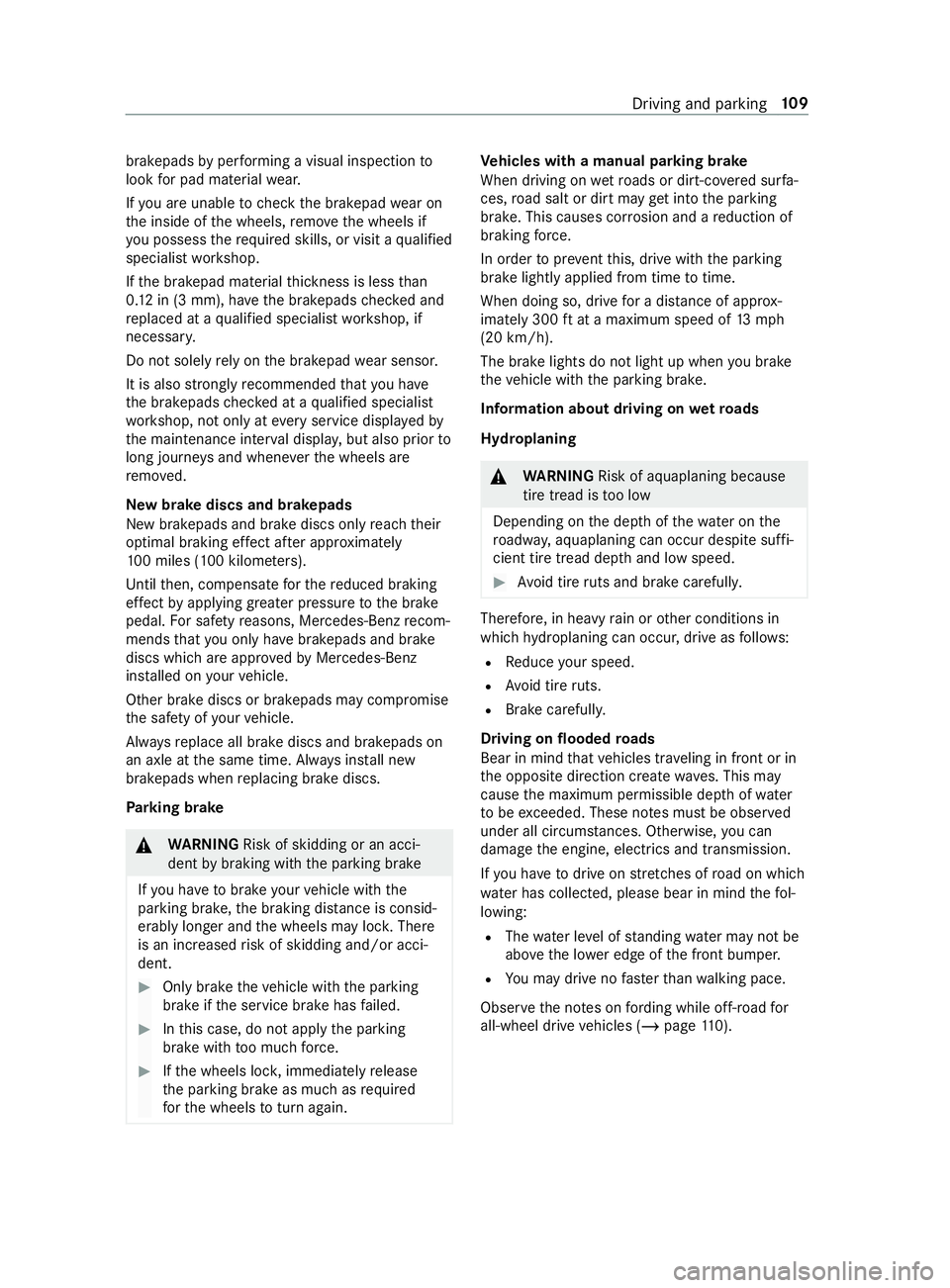
brakepads
byper form ing avisual inspection to
look forp ad material wear.
If yo ua reunabl etoc heckthe brakepad wear on
th ei nside of thew heels, remo vethew heels if
yo up ossess ther equired skills, or visit aqualified
specialis tworks hop.
If th eb rake pad material thickness is less than
0. 12 in (3 mm), ha vetheb rake pads checkeda nd
re placed at aqualified specialis tworks hop, if
necessar y.
Do no tsolely rely on theb rake pad wear sensor.
It is also strongly recommended that youh ave
th eb rake pads checkedataq ualified specialist
wo rkshop, no tonly at everyservice displa yedby
th em aintenanc einter vald ispla y,but also prior to
long journe ysand when ever thew heels are
re mo ved.
Ne wb rake discs and brakepads
Ne wb rakepads and brak ediscso nly reac ht heir
optimal braking ef fect af tera pproxima tely
10 0m iles( 10 0k ilome ters).
Unti lthen, compensat efor ther educed braking
ef fect by applying greater pressur etothe brake
pedal. Fors afet yr easons, Mercedes-Benz recom‐
mends that youo nlyh aveb rake pads and brake
discs whic hareappr ovedbyM ercedes-Benz
ins talled on your vehicle.
Other brak ediscs or brakepads ma ycompromise
th es afet yofy ourvehicle.
Alw aysr eplace all brak ediscs and brakepads on
an axle at thes ame time. Alw aysi ns tall new
brakepads when replacing brak ediscs.
Pa rking brake &
WARNING Risk of skidding or an acci‐
dent bybraking wit hthe parking brake
If yo uh ave tobrak eyour vehicle wit hthe
parking brake, theb raking dis tance is consid‐
erab lylonger and thew heels ma yloc k. There
is an increased risk of skidding and/or acci‐
dent. #
Only brak ethe vehicle wit hthe parking
brak eift he service brak ehasfailed. #
Inthis case, do no tappl ythe parking
brak ewitht oo muc hforce. #
Ifth ew heels loc k,immediately release
th ep arking brak easmuchasr equired
fo rt he wheels totur na gain. Ve
hicles with amanual parking brake
When driving on wetroads or dirt-co vereds urfa‐
ces, road salt or dir tmayget intot he parking
brake. This causes cor rosion and areduction of
braking forc e.
In order topreve ntthis, driv ewitht he parking
brak elightl yapplied from time totime.
Whe ndoing so, driv efor ad ista nce of appr ox‐
imatel y300 ftat am aximum speed of 13mph
(20 km/h).
The brak elights do no tlight up when youb rake
th ev ehicle wit hthe parking brake.
Information about driving on wetroads
Hydroplaning &
WARNING Risk of aquaplaning because
tir et read istool ow
Depending on thed epth ofthew ater on the
ro adw ay,a qu aplaning can occur despit esuffi‐
cient tir etread dep thand lo wspeed. #
Avoid tir eruts an dbrake carefully. The
refore ,inh eavy rain or other conditions in
whic hhydroplaning can occu r,driv easf ollows:
R Reduce your speed.
R Avoid tir eruts.
R Brak ecarefully.
Drivin gonflooded roads
Bear in mind that vehicles tr aveling in front or in
th eo pposit edirection creat ewaves. This may
cause them aximum permissible dep thofwa ter
to be exc eeded. These no tesm ustbeo bserved
unde rall circum stances. Otherwise, youc an
damag ethe engine, electrics and transmission.
If yo uh ave todriv eons tret ch es of road on which
wa terh as collected, please bearinm indthef ol‐
lowing:
R The wate rleve lofs tandin gwater ma ynotbe
abo vethel ow er edg eofthe front bumper.
R Youm aydriv enof astert han walkin gpace.
Obser vethen otes on ford ing while off- road for
all-wheel driv evehicles (/ page110). Driving and parking
109
Page 135 of 322
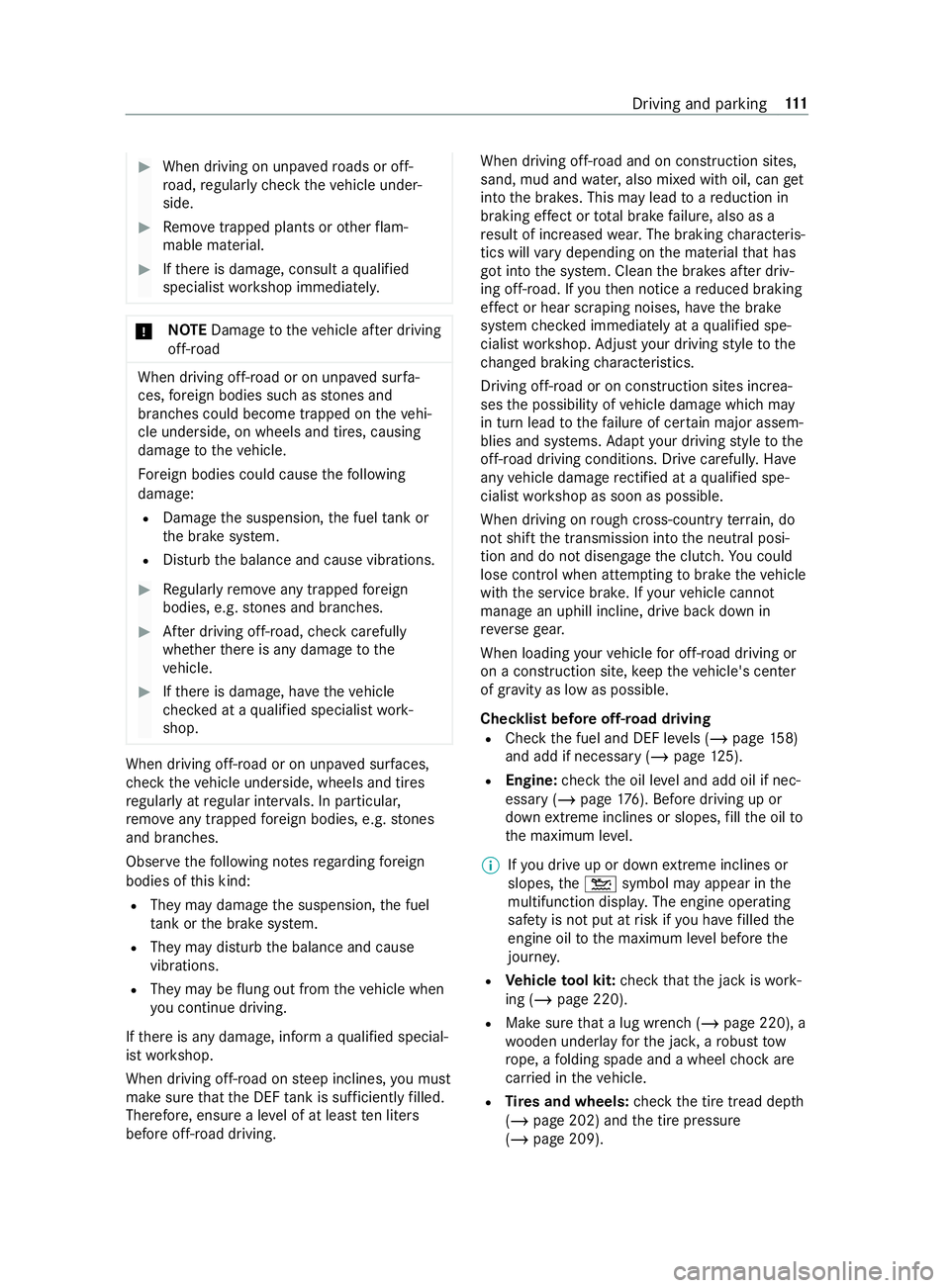
#
When driving on unpa vedr oads or off-
ro ad, regular lych eckt he vehicle under‐
side. #
Remo vetrappe dplants or other flam‐
mable material. #
Ifth er eisd amage, consult aqualified
specialis tworks hop immediately. *
NO
TEDama getothev ehicle af terd riving
off-road When driving off-road or on unpa
veds urfa‐
ces, fore ign bodies suc hasstones and
branches could become trapped on thev ehi‐
cle underside, on wheels and tires, causing
damag etothevehicle.
Fo reign bodies could cause thef ollowing
damage:
R Damag ethe suspension, thef uel tank or
th eb rake system.
R Disturb theb alance and cause vibrations. #
Regular lyremo veanyt rapped fore ign
bodies, e.g. stones and branches. #
Afterd riving off-road, checkc arefully
whe ther ther eisa nydamag etothe
ve hicle. #
Ifth er eisd amage, ha vethev ehicle
ch eckedataq ualified specialis twork‐
shop. When driving off-road or on unpa
veds urfaces,
ch eckt he vehicle underside, wheels and tires
re gularly at regular inter vals. In particular,
re mo veanyt rapped fore ign bodies, e.g. stones
and branches.
Obser vethef ollowing no tesr egarding fore ign
bodies of this kind:
R Theym aydamag ethe suspension, thef uel
ta nk or theb rake system.
R Theym aydisturb theb alance and cause
vibrations.
R Theym aybe flung out from thev ehicle when
yo uc ontinue driving.
If th er eisa nydamage, infor maqualified special‐
is tw orks hop.
When driving off-road on steep inclines, youm ust
mak esuret hat theD EFtank is su fficientl yfilled.
Therefore, ensur ealevelofatl eastten liters
befor eoff-road driving. When driving off-road and on con
stru ction sites,
sand ,mud and water,also mixed wit hoil, can get
int ot he brakes. This ma ylead toareduction in
braking ef fect or total brak efailure, also as a
re sult of increased wear.T he brakin gcharacteris‐
tics will vary depending on them aterial that has
go tint ot he sy stem. Clean theb rake sa fter driv‐
ing off-road. If yout hen notice areduced braking
ef fect or hea rscraping noises, ha vetheb rake
sy stem checkedi mmediately at aqualified spe‐
cialis tworks hop. Adjus tyour driving styletot he
ch anged brakin gcharacteristics.
Driving off-road or on construction sites increa‐
ses thep ossibility of vehicle damag ewhichm ay
in tur nlead tothef ailur eofc ertain major assem‐
blies and sy stems. Adapty our driving styletot he
off-road driving conditions. Driv ecarefull y.Ha ve
an yv ehicle damag erecti fied at aqualified spe‐
cialis tworks hop as soon as possible.
When driving on rough cross-countr yterrain, do
no ts hif tthe transmission int othe neutral posi‐
tion and do no tdisengag ethe clutch. Youc ould
lose control when attem pting tobrak ethe vehicle
wit hthe service brake. If your vehicle cannot
manag eanuphill incline, driv ebackd ownin
re ve rseg ear.
When loading your vehicle foro ff-road driving or
on aconstruction site, keep thev ehicle's center
of gr avity as lo waspossible.
Checklis tbefor eoff-road driving
R Chec kthe fuel and DEF le vels (/ page158)
and add if necessa ry (/ pag e125).
R Engine: checkt he oil le vela nd add oil if nec‐
essar y(/pag e176).Be fore driving up or
down extreme incline sorslopes,fill th eo ilto
th em aximum le vel.
% If
yo ud rive up or down extreme incline sor
slopes, the00B2 symbol ma yappear in the
multifunction displa y.The engine operating
saf etyisn otput at risk if youh ave filled the
engine oil tothem aximum le velb efor ethe
journe y.
R Vehicl etool kit: checkt hat thej ackisw ork‐
ing (/ page220).
R Mak esuret hat alug wrenc h(/pag e220), a
wo oden underla yfor thej ack, ar obus ttow
ro pe, afolding spade and awheel choc ka re
car ried in thev ehicle.
R Tire sa nd wheels: checkt he tir etread dep th
( / pag e202) and thet irep ressure
(/ page209). Driving and parking
111